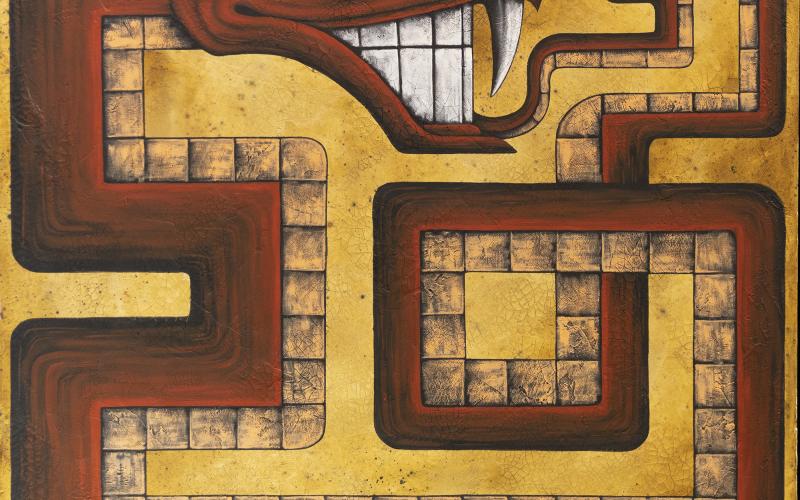Tonight, Thursday, Sept. 8, the Museum of the Cherokee Indian (MCI) opens Disruption, an art intervention of the Museum’s permanent exhibition. Featuring works by 36 enrolled members of the Eastern Band of Cherokee Indians (EBCI) and Cherokee Nation, Disruption is an artists’ response to the removal of funerary and culturally sensitive objects from public view.
Located on the Qualla Boundary, ancestral homelands of the Cherokee and home of North Carolina’s only federally recognized tribe, the Eastern Band of Cherokee Indians, MCI is one of the country’s oldest tribal museums. Its permanent exhibition opened in the Museum’s current building in 1998 and is toured by an estimated 83,000 visitors annually. In January 2022, one month following his appointment as Director of Collections and Exhibitions, Evan Mathis led an inventory of the Museum’s collections, consulting with EBCI Tribal Historic Preservation Office’s Lead Archaeologist Beau Carroll (EBCI), and numerous community members to identify funerary and sacred objects for removal.
“Native people have been fighting against these types of objects being on display in museums for decades—that’s why the Native American Graves Protection and Repatriation Act (NAGPRA) was created,” says MCI Director of Education Dakota Brown (EBCI). “NAGPRA was supposed to be the first step in the right direction, but there is a whole moral component that comes with caring for museum collections. As a tribal museum, we have even more of an obligation and responsibility to the objects, because we consider them ancestors, not just artifacts. The people who made these, who put their energy and creativity into those objects, used them, wore them—we’re being respectful of them.”
In lieu of empty display cases, MCI invited contemporary artists to disrupt the Museum’s chronological timeline through site-specific works, ceramics, paintings, carvings and sculpture, works on paper, multimedia works, and more. Though art was required to fit in the artists’ selected display cases, guidelines were kept to a minimum, facilitating honest reactions and uniquely creative interpretations. Participants include established voices like internationally-exhibited multidisciplinary artist Luzene Hill (EBCI), emerging millennials like printmaker Skye Tafoya (EBCI, Santa Clara Pueblo), and numerous first-time exhibiting artists and craftspeople who are the torchbearers of their family’s creative legacy.
“We reached out to artists who excite us, who are using ancestral methods and aesthetics, pushing the envelope, and coming up with something new that people haven’t seen before,” said Mathis. “Our hope is that visitors will see modern Cherokee people reflected back at them in this intervention.”
Disruption is also an opportunity for museum visitors to learn about repatriation, NAGPRA, and Indigenous collections care.
“An important piece for the public to understand is not only the laws that are in place, but also the moral responsibility,” says Brown. “We hope that explaining this throughout the exhibit will be helpful for our visitors.”
Disruption’s opening follows MCI’s announcement of its plans to build an off-site collections and archives facility and update its permanent exhibition, both long-term projects that will allow Mathis’s team to implement a collections care policy that prioritizes Cherokee cultural protocols and American Alliance of Museums’ core standards and ethics. The policy was approved by the MCI Board of Directors in July 2022. Museum staff look forward to providing a safe, secure home for material culture and ceremonial objects and a welcoming space for tribal members to view sensitive collections.
Plans for the Museum’s updated exhibition include an extended timeline (the current permanent exhibition ends around 1920) showcasing modern and contemporary Cherokee culture and artists. Disruption is a first step toward “disrupting” the chronological flow of the exhibition.
“Rather than define objects by a time period, we want to define them by a culture and show how it’s all tied together,” Mathis explains.
“We’re telling stories instead of following an archaeological timeline,” adds Brown.
Disruption will remain on view through Sept. 11, 2023. With an eye on the Museum’s future and ambitions to further exhibition and learning opportunities for Cherokee artists of all levels, Mathis and Brown welcome audiences to engage with this new interpretation of the Museum’s 24-year-old exhibition.
“This is where museums are headed,” says Brown. “It’s about being more responsible with collections and making sure that we are doing things in the most ethical way possible.”

